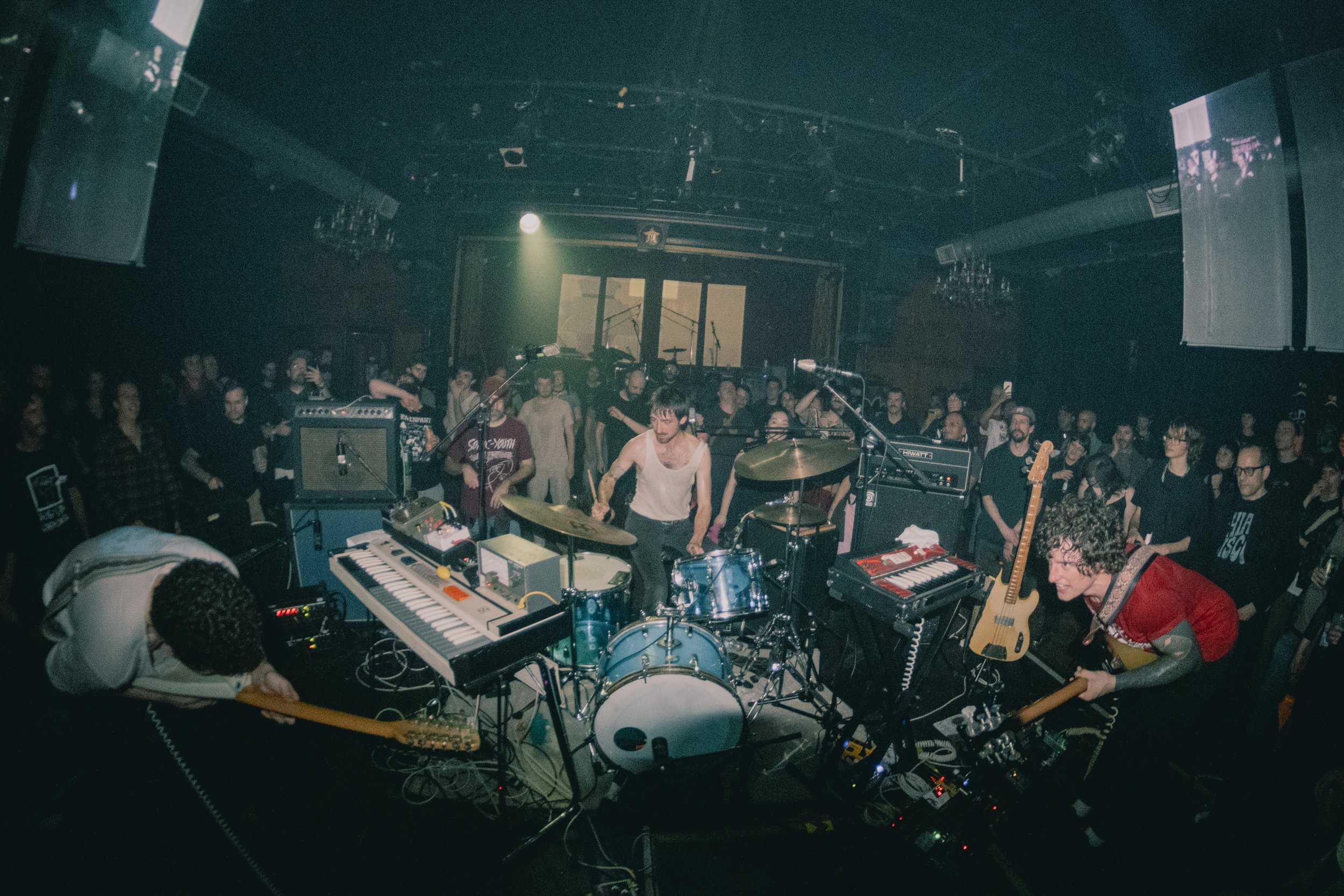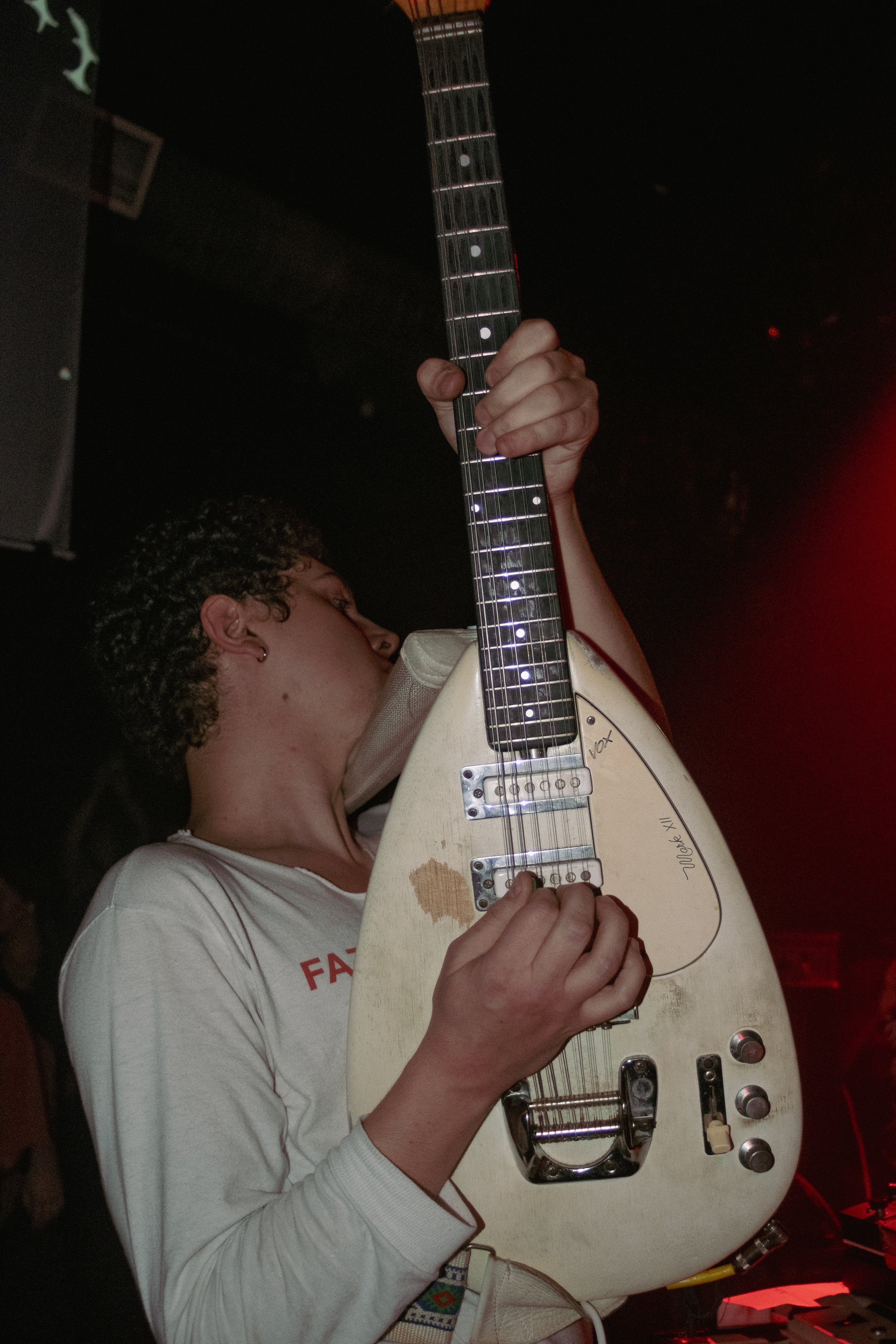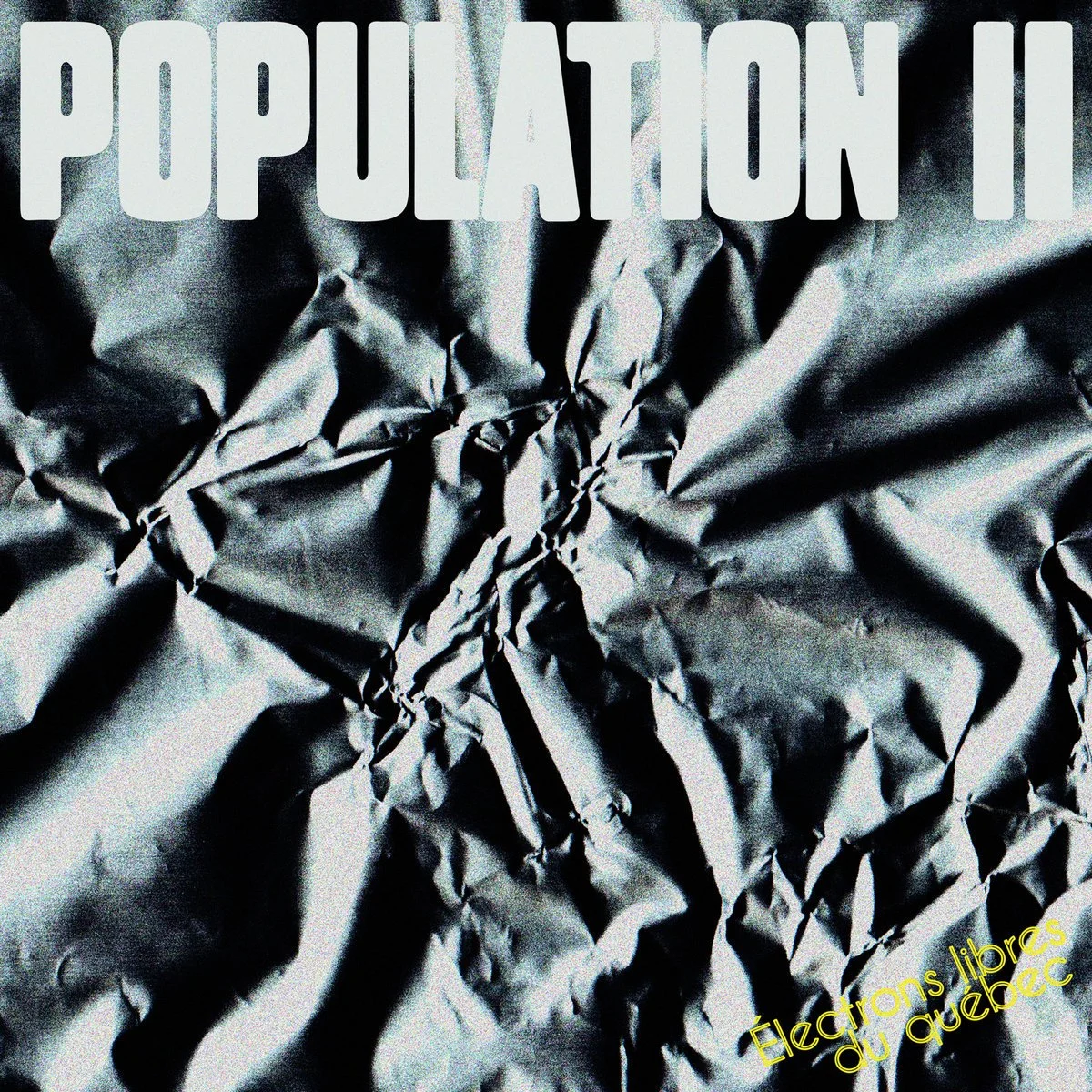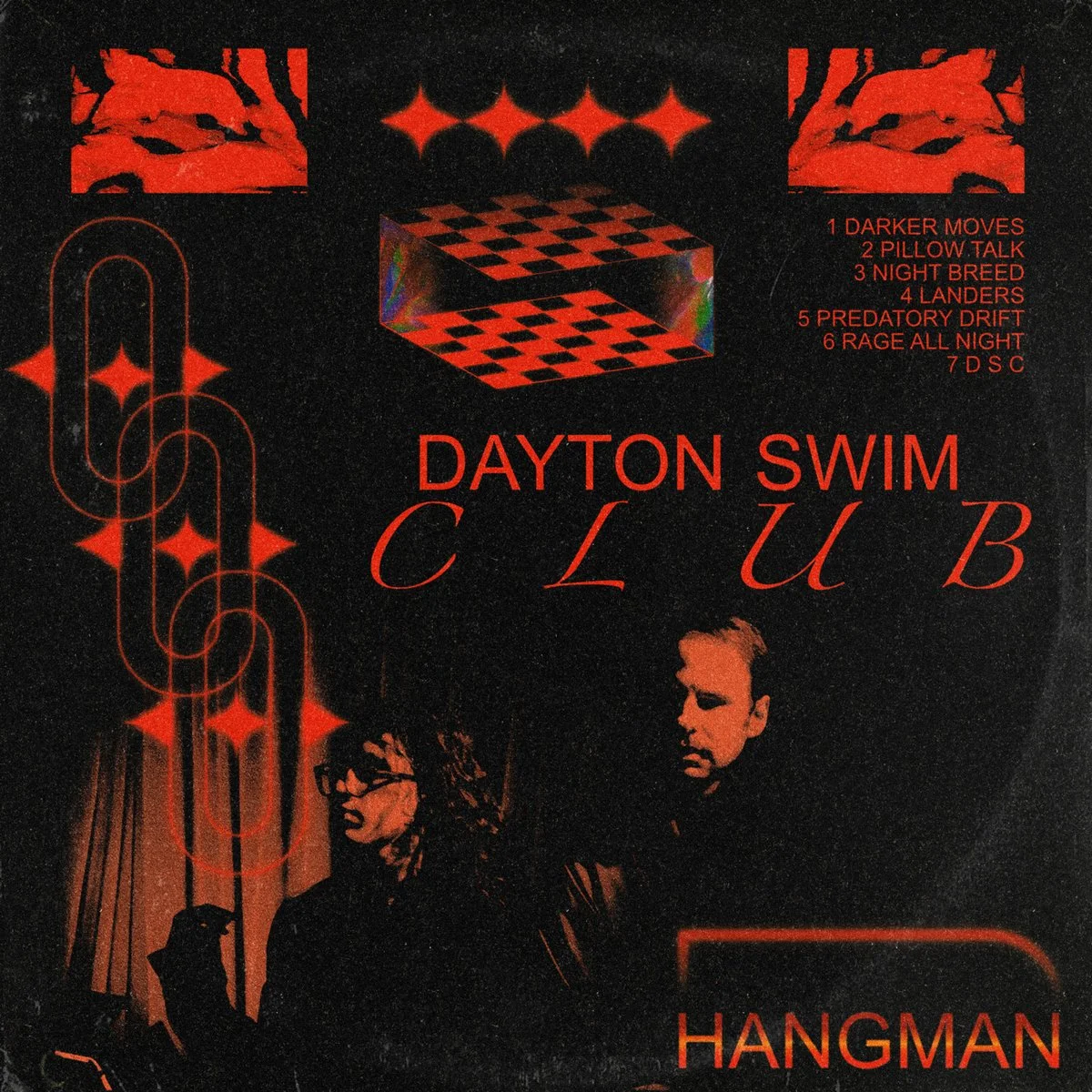Population II Get to the Heart of their Sound with Latest Album “Électrons libres du québec” (Bonsound)
Population II photographed by Starly Lou Riggs
Playful and alluring, Population II’s Électrons libres du québec is an enigma wrapped in a fever dream. These new sounds by the Montréal-based band hang above Earth’s atmosphere like a twisted multicolour satellite. Sure, it’d be easy to call them “psych-rock”, but that would be an oversimplification. Instead, this powerful trio successfully brews a multi-era potion, seamlessly collecting jazz fills, funky basslines, and emphatic synth in their intergalactic cauldron.
I had the honor of chatting with the band in their practice space—a treasure trove comprised of Tristan Lacombe’s synth and guitar pedal collection and Pierre-Luc Gratton’s drum set—complete with a rubber chicken in the kick drum (a gift from their tour, they tell me). The wall across from Sébastien Provençal’s bass gear is adorned with a cute Sesame Street-themed bedsheet. Ah, and don’t forget their iconic collection of troll dolls (my favourite is the one with earmuffs and a blue star belly button), as featured in the band’s L’Esco video interview, “L’Autel 4461”. Needless to say, it’s abundantly clear that this ragtag group have been friends for a long time.
In fact, they’ve all known each other since high school. Tristan, Pierre-Luc, and Sébastien all grew up in the North Shore, just north of Montréal. “[Tristan’s] father is the reason we’re playing together,” Sébastien laughs. “He’s like the guru of the band, if I can say, definitely a guru.”
Incidentally, some of the band’s early independent tracks caught the eye of John Dwyer—of the prolific rock band Osees—and Population II signed on with the rocker’s label. The group’s premiere album, Á la Ô Terre, came out hot on Castle Face Records in 2020. After returning from tour with the aforementioned legends, Population II are back in Québec with Électrons libres du québec, released via Montreal-based label Bonsound.
“We were at Ursa for [someone’s] show and I was going home very late to go to sleep,” Pierre-Luc recounts how they landed on their current label. “And then I received a call [from] someone and she’s like, ‘Hey, come to the park, there’s that person who works for Bonsound.’ So I go to the park and I talk with Valérie [Bourdages]… We talked for, like, two or three hours.” Pierre smiles and adds, “And the next week, we were on Bonsound.”
Population II photographed by Starly Lou Riggs
Pierre-Luc, Tristan, and Sébastien have a sweet and honest chemistry that comes through in their music. It’s truly as if they can read each other’s minds. That could explain how their music is so bold and intricate, yet seems to come naturally. “We’re really fortunate to have crossed paths and to have this sensibility for the same music and art. We’ve been playing since we were fourteen/fifteen, so sometimes we don’t even talk,” Sébastien speaks to their innate intuition together.
While the three have known each other a long time, Pierre-Luc is the newest addition to the band. Tristan explains, “We had a different line-up of that band and it was instrumental music. It was basically just jams and we were making long songs with a different drummer. And then we wanted to play with Pepe [Pierre-Luc]. In the first months that we were playing together, he was playing and one time had a mic and started singing. And [it] completely changed the band.”
“Not singing like a karaoke singer,” Sébastien adds with a big grin, “It’s more like face-melting. Like, ‘How in the world did that little guy do that?’”
“Our first band broke up and we had a show booked,” Tristan recounts. “It was at L’Esco, and when we were kids it was really big, so we couldn’t cancel. So we were just like, ‘Okay, we have to do this show,’… We had to play that show and then we added Pepe and he just added his personal background.”
Pierre-Luc’s lyrics are simple. His vocals act as an instrument all their own—impressive, as he is the drummer and lead singer. These belting vocals, akin to ‘60s garage-style, compliment the wall of sound in instrumental: Tristan’s alternating synth and guitar, and Sébastien’s booming bass. Pierre-Luc shares that his words are meant to “break the fourth wall”.
Électrons libres du québec is truly a powerhouse of an album. From the space-like sonics of “Orlando”, to ripping funky bass licks in “Beau baptême”, to the discorded cacophony of “Pourquoi qu’on dort pas”, the whole thing screams epic.
Listening with a fine-tooth comb, their influences seem fairly visible to the naked eye: ‘60s and ‘70s psych rock, definitely some classic jazz, and the likes of Funkadelic. Admittedly, Population II are very open-minded when it comes to music. We chatted about Sébastien’s dad being a ‘70s disco DJ (very cool), Pierre-Luc’s use of 6/4 jazz timing, and Tristan's affinity for exploring all genres.
“Oh yeah, there’s a lot of jazz. You wanna talk about that jazz, all that jazz? We’re all about the jazz,” Sébastien says emphatically of the band’s rhythm. All that, before leaving me with a list of recommended bands to add to my roster: ‘60s German band CAN, Canterbury scene legend Robert Wyatt, and Canadian ‘70s rock bands Simply Saucer and Aut’Chose .
“There’s something good in a lot of different genres,” Pierre-Luc says as the band reflects on their own “genre”.
“I literally listen to everything and I don’t want to stop myself,” Tristan tells me. “When I was younger, I was trying to be this cool kid: ‘Pop music is not for me. Oh, I don’t like country.’ And one day, I had a narrative shift. I want to be able to love everything.”
Tristan Lacombe of Population II, photographed by Starly Lou Riggs
“Mainly on Électron, we were really listening to those Canterbury prog bands like Soft Machine,” Tristan explains. “Mixing that with like… Krautrock bands that we love, and just a more naïve and primal energy of early proto-punk. Basically, it was a dumb and really naïve way of playing those styles of music.” While Tristan says naïve, what I hear is “experimental”. Population II has this in abundance—a childlike wonder for music and a desire to just play.
As it turns out, the band writes most of their songs in an improvisational way, jamming out ideas. They record their sessions and revisit from there. “We’re always, always recording,” Sébastien says. “Ideas are always flowing and it’s just because there’s this chemistry, this weird chemistry about the three of us being in a room.” Sometimes he’ll come in with some bass lines as a “foundation”, but the band seems to thrive on improvisational form.
All the music videos for Électrons libres du québec came to fruition in a similarly experimental fashion. Released both individually and as one full-album piece, Bonsound’s own Hugo Jeanson is the genius behind the strange colourful masterpiece. Tristan explains, “He wanted to have something that would work with the cover, just textures and stuff… We just had total confidence with him and we were just like, ‘Do your thing, have fun!’ And it looked good.”
“What was really cool,” Sébastien adds, “is that when we invited him [to] the rehearsal spot, he saw the whole vibe… He asked us to play every song on the records and he filmed us.”
Tristan was a fan of Hugo Jeanson’s visual art before they got the chance to work with him. “It was strange,” he mentions, “because since I was a teenager, I knew about his posters and stuff.” Hugo’s a bit of a music poster icon in Montréal, now operating as the Head of Label Marketing with Bonsound. “Yeah, we were just like, ‘Okay, this guy is the one who is making those crazy posters, he has good taste in music, he works there [Bonsound], we wanna work with this person.”
The band has had some luck, stumbling upon talented artists to join them on their journey. Pair this luck with musical skill, a charming demeanour, and a curiously open mind, it’s really no wonder the trio has come to put out such a killer record. “There’s a lot of layers to the band,” Sébastien tells me as we wrap up our conversation. “You just gotta witness us and hang out with us.”
The group laughs as Pierre-Luc sums it up this way: “In the end, we’re just normal guys shredding.”
Électrons libres du québec
released October 6, 2023 via Bonsound
1. Orlando
2. C't'au boute
3. C.T.Q.S.
4. Beau baptême
5. Tô Kébec
6. Lune Rouge
7. Réservoir
8. Rapaillé
9. Pourquoi qu'on dort pas
Pierre-Luc Gratton – percussion, vocals
Tristan Lacombe – guitar, organ, oscillator, piano, synthesizers
Sébastien Provençal – bass guitar, synthesizers
Emmanuel Éthier – violin on “Reservoir”
Colin Fisher – saxophone on “Pourquoi qu'on dort pas,” “Réservoir”
Emmanuel Éthier – production and mixing
Trevor Turple – sound engineer





































